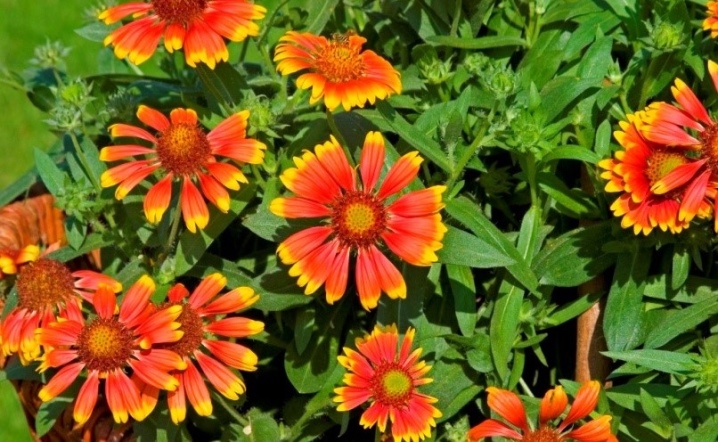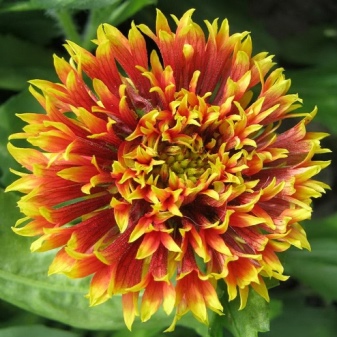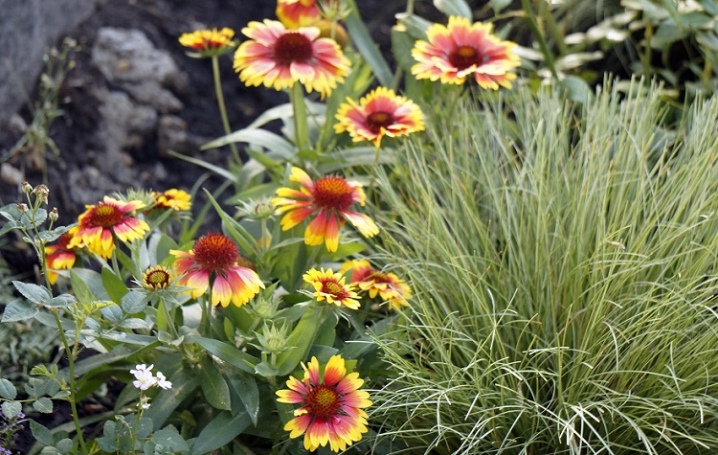Gaillardia: description and varieties, planting and care

Gaillardia are rare flowers, so richly bright, beautiful and so unpretentious to care for, like their wild ancestors from the distant American prairies. In ancient times, women of the Aztec and Maya tribes gladly decorated their hairstyles with them on the eve of holidays and ceremonies. Their color spectrum is so colorful and diverse that makes this plant truly versatile in its decorative use. In the article, we will consider in more detail the description and varieties of Gaillardia, as well as the subtleties of planting and care.

Peculiarities
Gaillardia is a culture from the Aster family, originally from the North American continent (the official symbol of Oklahoma, enshrined in the US constitution). It is a drought tolerant annual or perennial herb. Its flowers delight the eye with juicy, festive shades reminiscent of the sun. In the central part of the inflorescences are bright red to bronze shades or deep pink. The edges of the flowers (petals) are serrated, usually of a thick yellow color. The leaves are spatulate or round, slightly elongated, usually covered with hairs.


The culture features are as follows:
- grows in the form of a bush, leaves are simple;
- flowers are round with uneven edges, form simple (less often lanceolate), double or semi-double baskets, located one by one;
- simple flowers are formed by a single-row group of petals along the perimeter, in the central part of which there are tubular petals;
- semi-double, formed by several rows of petals;
- for terry types, funnel-shaped petals are characteristic, forming inflorescences;
- the culture is distinguished by an intensive flowering process and an original fruit in the form of achenes with a crest;
- it has a long flowering (before frost);
- for a long time does not fade when cut;
- productively grown in one place (up to 45 years), then require transplantation.


Gaillardia owes its name to the French lawyer Gaillard de Charentono, a famous amateur botanist, after whom Gaillardia is named. One-year-old Gaillardia grow up to 0.5–0.7 m, branch densely and bloom very profusely. Often, the plant is difficult to distinguish from its relative - rudbeckia, the description and appearance of which are in many ways similar. However, in rudbeckia, the central part of the flower is more convex, and its petals are more elongated than in Gaillardia.
Gaillardia is a bushy plant with highly overgrown or straight stems and a strong, horizontal root system. There are also dwarf variants growing up to 25–35 cm. Garden crops are diverse, differing in color and size. For this reason, Gaillardia has become so popular in organizing cultural landscapes.

Types and varieties
The names of varieties and their varieties are sonorous and memorable - to match the colors. In total, about 30 plant variants are known. Of the main garden options, there are 3 types of Gaillardia (with their varieties).
- Hybrid - grandiflora (large-flowered), obtained by crossing the spinous and beautiful. It is a perennial with straight, somewhat pubescent stems curving downward. The plant is tall, up to 75 cm. Near-root leaves are lanceolate or rounded. Inflorescences are up to 12 cm in diameter. The colors are rich, with orange, yellow or copper-red tints.
The plant blooms in early June.

- Spinous - perennial with straight shoots, up to 80 cm in height. Baskets of inflorescences are large, up to 12 cm in diameter, orange or deep red shades.

- Beautiful ("Krasava") - the most popular annual, which stands out for the variety of colors. Its variety is the original "Lorenziana", characterized by spherical inflorescences, consisting of reddish-yellow flowers with a funnel-shaped structure.


Consider the following most common varieties of hybrids:
- "Zone" - two-flowered bushes that are up to 60 cm in diameter; inflorescences - up to 10 cm in diameter, with dark yellow or golden petals;

- "Kobold" presented with a branched stem system, reaches up to 40 cm in height, with large, intense yellow petals and reddish edges;

- "Arizona Sun" (Gaillardia hybrida Arizona sun) - dwarf, no higher than 20 cm; this plant blooms richly from summer to frost;

- Arizona Red Shades forms neat, low-growing plants, up to 30 cm in height; in rosettes forms 7–8 peduncles with large flowers up to 12 cm in diameter; this variety blooms until September, does not require insulation for the winter;


- "Primavera" - low-growing bushes, up to 25 cm; up to 6–8 peduncles with baskets grow in the outlet, about 12 cm across;

- "Burgunder" ("Burgundy") remembered for the brightest, lush flowers of red red color with miniature yellowish specks;


- Tokajer - a tall perennial with dense orange petals;


- Golden Goblin - dwarf, with long-flowering yellow inflorescences;

- "Amber" - a culture up to 75 cm tall, with large flowers of a sunny yellow color, blooming before the onset of cold weather;

- "Oriental patterns" - bushes about 60 cm in height, with a yellow-purple floral center and copper-red petals and yellowish edges;

- "Primavera" - low-growing bush (up to 25 cm), single rosettes of which are crowned with up to 8 peduncles; it has large cherry-colored flowers with golden-yellow petal edges; the stems are richly covered with dense green leaves with an unexpectedly light middle; often planted in balcony containers;

- "Jasper" - a tall bush (up to 85 cm), the elongated stems of which are crowned with significant dimensions of the inflorescence of red-yellowish shades; flowering period - June and August; looks great in bouquets;

- "Arizona Apricot" - low-growing perennial bushes, about 30 cm high; large, warm apricot flowers bloom on neat bushes in July and bloom for a long time; elegant and non-capricious plant;


- Arizona Red Shades - hardy, unpretentious, long-flowering plant, up to 30 cm high;


- Mesa Peach - a culture with pronounced yellowish-orange inflorescences and long pedicels.


Optimal disembarkation time
The hardened sprouts of the culture are usually planted in the soil by the end of summer. If the planting rules are observed, the seedlings have time to put down strong roots before the cold weather arrives and give 8-10 strengthened leaves. The plant blooms in spring. If the culture is planted in the soil, bypassing the seedling stage, then the sowing is done by the end of spring. The seeds are placed in small holes, and when the sprouts are taken in, they become strong, the third leaf will sprout, they are transplanted into flower beds.

How to plant?
Gaillardia is light-requiring, requires unshaded soil areas. The culture is satisfied with prepared light, slightly acidic and not waterlogged soils. Bushes should be planted in open ground at a distance of 30–35 cm. To increase their density, it is allowed to place 2-3 pieces in a hole. During planting, fertilize with humus, ash, compost and mineral compounds (35–40 g per 8–10 l of water).
Then the bushes are watered abundantly.

The seed sowing order is as follows:
- containers are filled with well-moistened soil;
- sowing is performed in February or March, sprinkling with vermiculite substrate;
- the seeds are distributed shallowly and evenly;
- containers are placed in illuminated places at a temperature of + 20– + 23 ° C, regularly moistening the soil;
- sowing is covered with a film;
- after 12-14 days, the sprouts that appear are placed in cooler conditions (for example, in a greenhouse);
- sprouts at the stage of development of the third leaf dive into small containers, providing low-intensity watering and good illumination for 14 hours, using lamps.

Important! Low illumination of plantings contributes to the defeat of crops by gray rot. To preserve varietal purity, different species should be planted separately, taking into account the plant's ability to self-pollination and self-seeding.

How to take care of it properly?
Crop care includes careful watering, a garter, and shelter for the winter. Gaillardia is a frost-resistant plant, its cultivation does not require significant labor costs, but with the expected sharp temperature drop, gardeners advise to insulate it with fallen leaves or coniferous spruce branches.
The hybrid culture blooms annually from June until the onset of cold weather and, as a rule, the formation of buds is carried out without problems. Nevertheless, for its productive flowering, you should adhere to the following rules:
- an abundance of light;
- loose and light soil;
- watering - from moderate to scarce;
- timely cutting of withered shoots;
- rejuvenation of overgrown bushes.


Watering
The culture does not require abundant watering - excess moisture can lead to root rot and various diseases. That is why it is watered sparingly and rarely.
During rainy periods, watering is often excluded - the bushes have enough rainfall.

Top dressing
Perennial Gaillardia are fed on average up to three times a season, namely:
- with the beginning of the bud formation stage;
- during the most intense flowering (July and August);
- in autumn, at the end of the cut of flowers (September - October), 21–28 days before frost.
For feeding, formulations intended for flowers (composts, humus) are used. Manure is not suitable for these purposes.

Pruning and garter
The culture does not need pruning, but to give it a "marketable" appearance and stimulate budding, faded shoots must be removed. Such an operation, carried out in September, helps to avoid autoseeding. Old 5-year-old bushes usually lose their decorative effect: they deform or fall apart. Therefore, once every 3-4 years, the plant must be rejuvenated by division. Tall varieties need to be tied up, as they often break and fall.
For supports, branches or stems of other crops growing nearby, with strong peduncles, are used.


Transfer
Gaillardia grows well up to 4-5 years in one place without replanting, then requires soil renewal. It is better to transplant by dividing the bush at the beginning of spring or autumn.

Seed collection
In order to collect seeds, wilted flowers are reliably covered with gauze and firmly fixed, preventing them from falling to the soil. Until the beginning of autumn, they are stored in such a "package", and then they are collected. Propagation of Gaillardia by seeds is not particularly popular, since the bushes grown in this way differ from the original product, they will not fully comply with varietal standards.
For the preservation of the "marketable" type, perennials are often planted by the bush method.

Wintering
The homeland of Gaillardia is the North American continent, therefore, genetically, the plant is capable of tolerating cold and does not need special preparation for winter. Gardeners can sprinkle the plant with fallen leaves for insurance or mulch the soil with peat.

Reproduction methods
Annual crops are usually propagated by seed, and perennial crops are usually propagated by splitting shrubs, cuttings and seeds. The bushes are separated in spring and autumn. Seeds are sown before the onset of winter cold weather or in spring on open soils. Perennials grown from seeds bloom next year.
The simplest breeding method for perennials is to divide the bushes. The method is especially productive for bushy specimens, since they grow extremely slowly. Gardeners advise to separate them in April or in the fall, at the end of pruning.
The wells are watered before transplanting and humus is introduced.

Seeds
For the seed fund in the fall, a number of bushes are specially preserved to ripen the seed supply. Then the seeds are packed, dried for spring sowing. When planting, they are not placed in the ground more than 0.5–1 cm, otherwise they will not germinate. Then the landing site is watered and covered with a film. The sprouts usually erupt in less than two weeks. They dive at the stage of emergence of 2-3 leaves. The hardened sprouts are planted in open places before winter or in the coming spring. Flowering begins in the second year.
Important! Perennials reproduce intensively by auto-sowing, but the color of flowers in newly grown bushes can vary significantly.

By dividing the bush
Rhizomes of mature, 4-5-year-old plants are removed from the ground, then cut with a knife into 2-3 parts, each of them includes both root and aerial elements. Excessively small parts do not take root well and are difficult to bloom. Usually 3 plants are obtained from 1 bush.
The transplant is carried out in the spring.

Cuttings
Often, gardeners use root cuttings for propagation. For this purpose, the plant is dug in around the circumference and carefully removed from the soil. Then the large roots are cut off and divided into pieces of 5 cm each. Then they are folded semi-horizontally in a greenhouse. Controlling the moisture content of the soil, spraying the upper part, when the roots appear, they transfer the material for adaptation to a mini-bed for rooting the roots.
The method is used if it is required to obtain a significant number of bushes of the same variety.

Diseases and pests
Waterlogged soils contribute to the infection of the culture with fungal diseases - gray mold, powdery mildew, leaf spot... Therefore, compliance with competent watering is the key to growing healthy bushes. If the leaves lose their proper appearance and gray formations appear, the infected leaves are immediately removed, and the bushes are treated with a manganese solution (2.5 g per 10 l of water).
When many plants are infected, the flower garden is treated with fungicidal agents.


Use in landscape design
The ability of culture to harmoniously combine with other cultures, for example, asparagus, chamomile, is widely used by designers when domesticating various landscapes or creating new ones. Gaillardia looks great in any flower bed, in flower beds or front gardens. Depending on the type and characteristics of the color, the culture is actively used, planting on balconies, loggias, window sills, curbs. At dachas, Gaillardia will successfully solemnly decorate the edges of the paths, will harmoniously contrast with the green of the lawns, and will be a bright outfit for alpine slides. The bouquets are harvested using varieties with elongated stems. Dried flowers are widely used to form wonderful compositions.
Tall species are advised to be planted together with tall crops with a strong stem system.


You can find out how to grow Gaillardia seedlings by watching the video below.







































































































The comment was sent successfully.